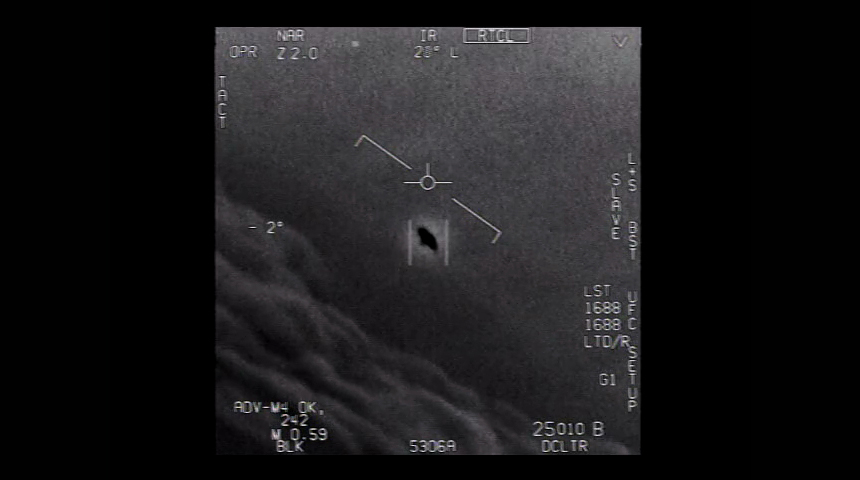7 out-of-this-world alien stories from 2022
Metallic spheres zooming past military jets, mysterious signals inside the world's largest telescope, and theories on why we have yet to make contact.

A metallic sphere zooms across the flight path of a military jet. A mysterious signal in the world's largest telescope sparks international alarm. And scientists discover that potential Martian life may have wiped itself out eons ago. It's been a busy year for all things out there. Here are seven out-of-this-world discoveries about aliens from 2022.
1. Zooming metallic sphere

In May, during the first public hearing on unidentified flying objects (UFOs) since the 1960s, Pentagon officials unveiled previously classified footage of a metallic sphere zipping across the flight path of a military jet. Recorded for just a few split-second frames in a video taken through the cockpit window of an FA-18 fighter jet in 2021, the strange object was also observed by the Navy pilot flying the jet and was picked up by the plane's sensors — but military experts say they have no clue what it was.
The officials were quizzed by lawmakers about the findings of a June 2021 report that detailed 144 Unidentified Aerial Phenomena (UAP) sightings. They were also asked about a rumored incident at Malmstrom Air Base in Montana that saw 10 nuclear intercontinental ballistic missiles (ICBMs) rendered inoperable while a glowing red orb was seen overhead. They did not divulge any details to confirm or deny the story.
Credible claims abound that most UAPs are prototype U.S., Chinese or Russian surveillance drones; hypersonic test vehicles; or even airborne trash. Both the Pentagon and NASA have announced new investigations that will attempt to separate these Earthly objects from any that could defy terrestrial explanation. Watch this space.
2. LIGO's search for an alien mother ship

Searching for weird objects in our own skies is one thing, but scientists have also proposed a way to look for them farther from home. By using one of the world's largest lasers, the U.S.-based Laser Interferometer Gravitational-Wave Observatory (LIGO), scientists said in December that they could scan the skies for the ripples in space-time left in the wake of large alien spaceships.
And by "large," they mean truly colossal — a ship would need to weigh roughly the same as Jupiter, travel at one-tenth the speed of light, and be within 326,000 light-years of Earth to make waves strong enough for LIGO to pick up. If that seems a little unrealistic, consider that the scientists also think a ship with an advanced warp-drive engine could produce detectable gravitational ripples; even leaving behind a signature for us to reverse engineer the technology.
3. Official protocol for contacting aliens

Despite all this talk of looking for aliens, scientists are still stumped on what we should do if we were to find them. That's why, in November, a group of policy experts and scientists announced the establishment of the Search for Extraterrestrial Intelligence (SETI) Detection Hub, a cross-disciplinary organization that will build a new alien contact protocol.
Sign up for the Live Science daily newsletter now
Get the world’s most fascinating discoveries delivered straight to your inbox.
A previous contact protocol had been written by the SETI Institute in 1989, but the document is largely focused on how discoveries should be shared with the public and other scientists, and offers only a vague sketch of a realistic international response to extraterrestrial communication — telling scientists to seek advice from the United Nations.
The new protocol will attempt to give humanity a little more cross-life-form social skills, helping scientists pick out potentially intelligent signals in space and deciphering their meaning, while also coming up with procedures, to be enforced through treaties, on how to respond to ET should it ever phone Earth.
4. An alien signal... or not

For just one day in June, the moment of first contact with intelligent aliens looked like it had already arrived, after scientists at China's enormous Five-hundred-meter Aperture Spherical radio Telescope claimed it was "likely" they picked up trace signals from an extraterrestrial civilization. The claims quickly went viral, spreading across Chinese state media and the Chinese social media platform Weibo before being reported by the international press.
But disappointment soon followed when Dan Werthimer, a SETI scientist and co-researcher on the project that spotted the signals, announced that they were almost certainly from human sources. Werthimer told Live Science that the narrow-band radio signal, at first so exciting to scientists because it usually comes only from artificial sources, originated from Earth-based interference that appeared inside the giant telescope much like an alien signal would. This isn't the first time space message watchers have been falsely alerted — another famous set of signals detected between 2011 and 2014 turned out to have been made by scientists microwaving their lunches. It almost certainly won't be the last.
5. A possible solution to the Fermi paradox

Perhaps the hardest part of alien contact is convincing them we're worth talking to. In December, a new paper proposed an interesting solution to the so-called Fermi paradox, or the apparent lack of other intelligent beings in spite of the almost infinite number of other worlds. Perhaps, to a distant observer, the research suggested, we look pretty boring.
Advanced aliens, the study argues, are probably interested only in signs of sophisticated technology rather than life alone and could have even visited Earth before humans evolved. It is only with the advent of radio technology in the 1930s that humanity would produce a technological signature for intelligent aliens to pick up on our existence, and even then, these messages usually get garbled into gibberish after traveling a light-year.
Perhaps it's that there are no intelligent civilizations within 1 light-year of our planet but there are plenty farther out. Or maybe they picked up on our radio signals years ago and their response, traveling at the finite speed of light, is on its way.
6. Collapsed alien civilization?

In May, scientists came up with another solution to the Fermi paradox, this time suggesting that advanced aliens might never contact us because they have rejected a growth-based system entirely.
Their new hypothesis proposes that, as space-faring civilizations grow in scale and technological development, they eventually reach a crisis point where innovation no longer keeps up with energy demands. What comes next is collapse. The only alternative path is to reject a model of "unyielding growth" in favor of maintaining equilibrium, but at the cost of a civilization's ability to expand across the stars and come into contact with humans.
7. Martian microbes doomed by climate change

Finally, it's possible that most life wipes itself out before it can even make itself known. In October, a climate modeling study of primordial Mars proposed that Mars and Earth may have once had similar atmospheres and were home to similar early microbes that consumed hydrogen to produce methane.
But because Mars is farther from our star than Earth is, it was more reliant on a fog of heat-trapping greenhouse gases, such as carbon dioxide and hydrogen, to maintain hospitable temperatures for life. So, as ancient Martian microbes ate hydrogen (a potent greenhouse gas) and produced methane (a significant greenhouse gas on Earth but less potent than hydrogen), they faced harsher consequences for eating into their planet's heat-trapping blanket than their cousins on Earth did, eventually making Mars too cold to foster the evolution of complex life.
The scientists' proposal, if accurate, could suggest that life may not be innately self-sustaining in every conducive environment it pops up in, and that it can easily wipe itself out by accidentally destroying the foundations for its own existence — a disquieting thought in our time of biodiversity loss, irreversible resource extraction and climate change.

Ben Turner is a U.K. based staff writer at Live Science. He covers physics and astronomy, among other topics like tech and climate change. He graduated from University College London with a degree in particle physics before training as a journalist. When he's not writing, Ben enjoys reading literature, playing the guitar and embarrassing himself with chess.









